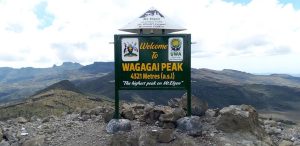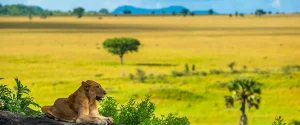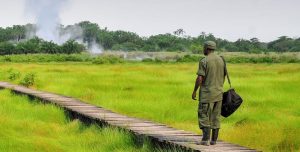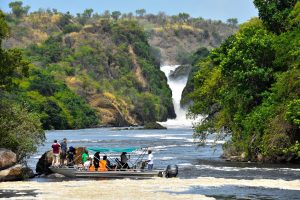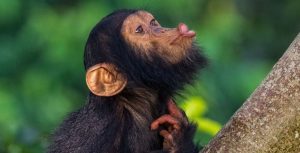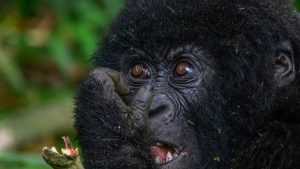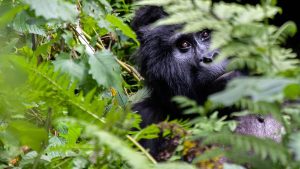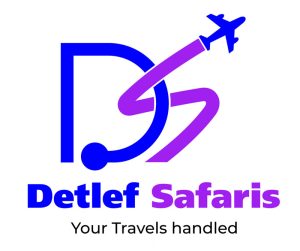Semuliki National Park
Semuliki Valley National Park is the first protected Area in Uganda and one of the most biodiverse parks in Africa. Covering an area of 220 square kilometers, the park lies on the border of Uganda with the DRC, south of Lake Albert, below the Kijura Escarpment and the northern foothills of the Rwenzori Mountains in western Uganda. Semuliki is situated in Bwamba County, a remote area in Bundibugyo district and it is approximately 52 km from Fort Port Tourism City.
Semuliki National Park’s forest are the eastern-most extension of the Ituri Forest of the Congo Basin giving a wonderfully remote introduction to the habitats of Central Africa without having to leave Uganda, the forest is also the only true lowland tropical forest in East Africa.
Wildlife in Semuliki National Park
Semuliki National Park is home to 53 mammals species including 2 types of flying squirrel and 6 types of bat including the Zenker’s flying mice. Semuliki is the only East African stronghold of the oddball water chevrotain/Fanged deer, a superficially duiker-like relic of an ancient ungulate family that shares many structural features with pigs and is considered ancestral to all modern-day antelopes and deer.
Semuliki National Park also hosts Forest elephants, buffaloes, bushpigs, Sitatunga, white bellied duikers, hippos and crocodiles, as well as 10 species on diurnal primates such as Central African red colobus monkeys, black and white colobus monkeys, Grey-cheeked Mangabey, Dent’s Mona Monkey, De Brazaa’s monkey, Red-tailed monkey, Vervet Monkey, Olive baboon, Blue monkey and Chimpanzee among others.
Birdlife in Semuliki National Park
Semuliki National Park hosts over 440 bird species including 9 hornbill species and 66% of Uganda’s total forest bird species. Among these are 131 of the 144 Guinea-Congo Forest Biome species including almost 50 species that cannot be found anywhere else in East Africa.
Other species found in Semuliki National Park include the African Dwarf Kingfishers, African Piculet, Bates’ Nightjar, Black Dwarf Hornbill, Black-collared Lovebird, Black-wattled Hornbills, African Goshawk, Ayres Hawk-Eagle, Cassin’s Spinetail, Great Sparrows, Red-thighed Sparrows, White-spotted Flufftail, Black-winged Starling, Brown-crowned Eremomela, Chestnut-breasted Negro finches, Chestnut-flanked Goshawk, Chocolate-backed, Crested Malimbes, Eastern Bearded Greenbuls, Forest Francolin, Forest Thrushes, Gabon Woodpecker, Grant’s Bluebill,Green-tailed Bristlebill, Grey Ground Thrushes, Hartlaubs’s Duck, Ituri Batis, Lemon-bellied Crombec, Maxwell’s Black Weaver, Northern Bearded Scrub Robin, Pale-fronted finches, Piping Hornbills, Red-bellied Malimbes, Red-billed Dwarf, Red-billed Helmet Shrike, Red-chested Owlet, Red-eyed Puff-back, Red-rumped Tinkerbird, Red-sided Broadbill, Red-thighed Sparrowhawk, Simple Greenbulls,Spot-breasted Ibis and Spotted Lyre-tailed Honeyguides among others
What to do in Semuliki National park
Uganda Safari Activities to do in Semuliki National Park
Game Drives
Game drives in Semuliki National Park provide an opportunity to explore the diverse ecosystems in the park and encounter a variety of wildlife species recorded to be 63 mammals. From the comfort of your safari vehicle, be on a lookout for several wildlife species including forest buffaloes, elephants, leopards, hippos, and numerous primates like baboons, vervet monkeys, and the rare pygmy antelopes.
Game drives in Semuliki National Park are conducted in the early morning and afternoon when animals are at their most active.
Birding
With over 441 recorded bird species, Semuliki National Park is a birder’s paradise. The park’s unique geographical location contributes to its rich avian diversity, including numerous central African species not found elsewhere in East Africa.
Key bird species to lookout for in Semuliki include frican Piculet, Maxwell’s Black Weaver, Blue-billed Malimbe, Yellow-throated Nicator, Black Dwarf Hornbill, Nkulengu Rail, Piping Hornbill, blue-billed malimbe, Yellow-throated Cuckoo and Leaf-love among others. Although birding in Semuliki can be done all year round, the best time is usually from December to February when migratory species arrive in the park.
Chimpanzee Trekking
The Indiana University habituated some clans of Chimpanzees that are now open for tourism. Chimpanzee tracking permits in Semuliki cost $30 for international visitor. While tracking chimpanzees, expect to spot smaller primates like black and white colobus monkeys, Central African red colobus, Dent’s Mona Monkeys, Central Africa red colobus, Dent’s Mona monkeys, grey-cheeked mangabey, Olive baboons and Red-tailed monkeys among many others.
Hot Springs Visit
Visit the beautiful Sempaya Hot Springs, loally known as “Nyansimibui” female hotspring and “Bintente” – Male hotspring. These fascinating geological features are a result from the geothermal activities along the East African Rift.
The female hot spring, Nyansimbi, is a hot expanse of bubbling water where visitors can enjoy the spectacle of cooking eggs or bananas in the naturally boiling water. The Male hot spring – Bintente is known for its geysers that can spray hot water up to two meters high. The surrounding vegetation, steam rising, and the gurgling sounds make the hot springs a magical and relaxing spot.
Nature and Hiking Walks
Nature walks in the forest together with a ranger guide, there are majorly three trails to follow inside Semuliki National Park. They include
- Red Monkey Trail – This 11 km long trail follows the park boundary to the east and ends up at the Semliki River. You have chances of sighting the rare DeBrazza monkeys.
- Sempaya Nature Trail – This trail leads you to the Sempaya hot springs. The walk is through a patch of forest where you most likely to encounter black-and white colobus monkeys, red tailed monkeys and grey-cheeked mangabey. Along the trail, you will visit the Male Hot Spring, pass the tree house where you view the abundant birdlife and beautiful scenery.
- The Kirumia Trail – This trail is 13 km is perfect for birders, it ends up at the Semliki River and traverses the forest.
Community Walks and Cultural Experiences
The Batwa once lived in the forest before it was made a national park, now they live on the boundaries of the park but often visit the forest in search of medicinal plants. They organize demonstrations of how they lived in the forest from gathering food, hunting, tools of how they lived and survived in the forest. Enjoy music and dance performances and remember to purchase handcrafts.
Getting There
By Road – From Fort Portal, it is a drive of 2 hours on the Fort Portal – Bundibugyo Road. From Kampala, the capital of Uganda, it is a drive of 6 hours and 350km via Kampala, Mityana and Fort Portal road to Semuliki National Park.
By Air – There are domestic and charter flights organized from Entebbe International Airport and Kajjansi Airstrip to Semuliki Airstrip. From here, you connect to the park by a vehicle. Note: flights to Semuliki Airstrip operate with a minimum of 4 people on board.
Where to stay in Semuliki National Park
There are several accommodation options in Semuliki National Park ranging from budget, midrange to luxury. These include
- Semuliki Safari Lodge
- Nyati Game Lodge
- Ntoroko Game Lodge
- Mountains of the Moon Hotel
- Kirimia Guesthouse
- UWA Bandas, Campsite and Cottages.
Best Time to visit Semuliki National Park
Semuliki National Park can be visited all year round but the best time to visit is during the dry season. While weather patterns are always changing, from December to March it is generally hot and dry. April to June see higher levels of more consistent rainfall. June to September is generally dry with occasional light rain, and October and November see short, but heavy, showers.

